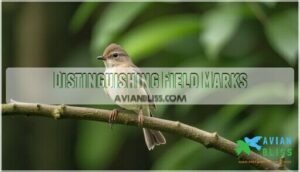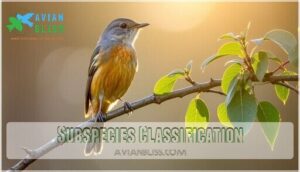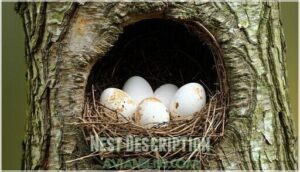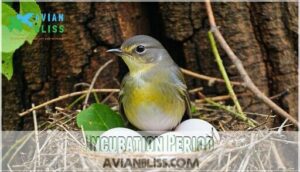This site is supported by our readers. We may earn a commission, at no cost to you, if you purchase through links.
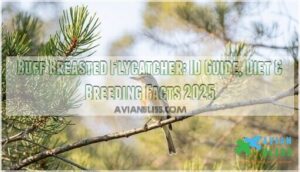
This tiny songbird measures just 4.3-5.1 inches with grayish-brown upperparts and white wing bars. Unlike its confusing cousins, the buff-colored breast makes identification straightforward.
You’ll find them in pine-oak woodlands and mountain canyons across the southwestern United States and Mexico. They’re aerial insectivores, snatching flies and small insects mid-flight with remarkable precision.
During breeding season, males perform distinctive flight displays while females build compact cup nests in tree forks. Understanding their unique vocalizations and seasonal behavior patterns reveals fascinating survival strategies.
Table Of Contents
- Key Takeaways
- Buff Breasted Flycatcher
- Flycatcher Bird Identification
- Buff Breasted Flycatcher Diet
- Nesting and Breeding Habits
- Conservation and Similar Species
- Frequently Asked Questions (FAQs)
- Are flycatchers aggressive?
- Where are flycatcher birds found?
- What is the buff breasted sandpipers habitat?
- Where do red-breasted flycatchers live?
- What is the range of the buff-breasted flycatcher?
- How do I identify a flycatcher?
- What is the Buff-breasted Flycatchers lifespan?
- Do Buff-breasted Flycatchers mate for life?
- How do Buff-breasted Flycatchers communicate with each other?
- Are Buff-breasted Flycatchers commonly kept as pets?
- Conclusion
Key Takeaways
- You’ll easily identify this tiny flycatcher by its distinctive warm orange-buff chest – the key field mark that separates it from other confusing Empidonax species.
- You’ll find them in pine-oak woodlands and mountain canyons of the southwestern U.S., where they’re aerial insectivores that catch flies and insects mid-flight.
- You’ll observe their compact cup-shaped nests placed in tree forks during breeding season, with females incubating eggs for about 14 days while males perform territorial flight displays.
- You’ll need to act quickly to spot them since their populations are declining due to habitat loss and climate change, making them increasingly rare compared to other flycatcher species.
Buff Breasted Flycatcher
You’ll recognize this tiny flycatcher by its warm buff-colored chest and sandy brown back – it’s North America’s smallest Empidonax species at just 4.5 inches long.
At just 4.5 inches, this buff-chested gem is North America’s tiniest Empidonax flycatcher.
This elusive bird prefers high-elevation pine-oak forests in southeastern Arizona, making it a challenging but rewarding find for birders.
Physical Characteristics
You’ll recognize this buff breasted flycatcher by its distinctive sandy brown back and warm buffy chest – key flycatcher characteristics that set it apart from other flycatcher bird species.
Physical identification features:
- Body Size – Smallest North American Empidonax at 4.5-5.1 inches long, weighing just 0.2-0.3 ounces
- Feather Color – Olive-gray upper bodies with signature buff-colored breast that gives this bird species its name
- Head Pattern – Conspicuous white eye rings create bold facial markings for reliable flycatcher bird identification
- Beak Shape – Small, thin bills perfectly designed for catching insects mid-flight like other flycatcher bird species
Habitat and Distribution
You’ll find buff breasted flycatcher in high-elevation pine-oak forest ecosystems, primarily in southeastern Arizona’s mountain habitats between 6,000-9,350 feet.
Their geographic range once extended farther north, but breeding grounds now concentrate in specific canyon systems.
These flycatcher habitat preferences make them vulnerable during migration patterns, as suitable forest ecosystems become increasingly fragmented, impacting bird conservation efforts.
Behavioral Traits
You’ll observe these tiny aerial acrobats displaying fascinating social behavior throughout their mountain territories.
Their flight patterns reveal precise hunting techniques and territorial boundaries.
Here’s what to watch for:
- Territorial Defense – Males establish territories through aggressive chasing and distinctive call sequences during breeding season
- Foraging Strategies – They perform characteristic "sally-and-return" flights, catching insects mid-air before returning to the same perch
- Social Behavior – Generally solitary except during mating rituals, when pairs engage in courtship flights and soft vocalizations
- Flight Patterns – Quick, darting movements with sudden direction changes make them challenging subjects for bird identification and bird watching tips
Understanding their small bird behaviors is essential for effective conservation efforts.
Flycatcher Bird Identification
You’ll find identifying buff-breasted flycatchers easier when you focus on their key field marks and understand the subtle variations that separate them from similar species.
Their distinctive sandy brown backs and warm buffy chest coloring make them stand out among North America’s smallest Empidonax flycatchers.
Though recognizing the six subspecies requires attention to specific plumage details and measurements.
Distinguishing Field Marks
You’ll identify this flycatcher through its distinctive buff-colored chest band and prominent white eye rings that create striking facial contrast.
The bird’s short, broad beak shape differs markedly from other flycatchers, while bold wing bars and warm feather colors across the upperparts provide reliable field marks for positive identification during bird watching expeditions, utilizing striking facial contrast.
Plumage Variation
You’ll notice feather color shifts subtly between individuals and seasons.
Adult buff breasted flycatchers display olive-gray upper bodies with distinctive warm buff coloring across their chest.
Wing patterns feature two prominent white wing bars that contrast against darker flight feathers.
Their tail feathers show brownish tones with lighter edging, and head plumes remain fairly uniform, though lighting can affect how the buff coloring appears in flycatcher habitat during ornithology research studies focusing on avian ecology.
Subspecies Classification
Six named subspecies exist within Buff breasted flycatcher taxonomy, with most U.S. records representing the pygmaeus subspecies.
The pygmaeus subspecies dominates U.S. buff-breasted flycatcher populations, showcasing nature’s taxonomic precision.
Classification systems rely on phylogenetic analysis to distinguish genetic variation among populations.
Ornithology research reveals subtle differences in measurements and plumage across subspecies.
These taxonomic distinctions help researchers understand avian ecology patterns and flycatcher habitat preferences. Species identification becomes more precise when you recognize these subspecies variations through detailed field observations.
Buff Breasted Flycatcher Diet
You’ll discover that buff-breasted flycatchers are skilled insect hunters, catching their prey through quick aerial maneuvers and perch-hunting techniques.
Their diet consists primarily of flying insects like flies, moths, and small beetles, which they snatch from the air or pluck from vegetation surfaces, making them efficient flycatchers.
Food Sources
During peak hunting seasons, insect prey dominates the buff-breasted flycatcher diet, with beetles and flies comprising over half their intake.
You’ll find these specialized hunters targeting Lepidoptera caterpillars when feeding nestlings.
Seed eating occurs rarely during insect shortages, while fruit consumption remains minimal.
Pollen collection happens accidentally during foraging, supporting wildlife conservation efforts through pollination services.
The buff-breasted flycatcher’s dietary needs are influenced by its natural bird food sources, which play a vital role in its overall health and well-being.
Foraging Habits
You’ll watch as these birds switch between Foraging Strategies during flycatcher migration.
They perch upright on favorite spots and fly out to catch insects midair.
During breeding season, they forage in pairs, but hunt solo otherwise.
Their Hunting Techniques involve flycatching from very low perches, sometimes just inches off the ground.
This Feeding Behavior helps maintain their energy for flycatcher nesting activities.
The birds’ diet consists of various insects and can be supplemented with proper flycatcher food sources, which is crucial for their overall well-being.
Nutrition Requirements
Your buff-breasted flycatcher needs specific nutrient needs to fuel its aerial acrobatics and seasonal migrations.
These tiny athletes have strict energy requirements that shape their feeding habits and survival strategies.
- Protein-rich insects provide essential amino acids for muscle development and feather maintenance
- High-fat content prey like beetles supply concentrated energy for flycatcher migration journeys
- Calcium sources from exoskeletons support bone strength and egg production during flycatcher nesting season
Nesting and Breeding Habits
You’ll find these small flycatchers nesting in carefully chosen spots within their pine-oak forest habitat, typically placing their compact cup-shaped nests in the fork of horizontal branches.
Their breeding season runs from late spring through early summer, with females incubating eggs for about two weeks while showing distinctive brood patches that help distinguish them from males during this critical period, which is a key aspect of their breeding season.
Nest Placement
You’ll find these flycatchers strategically selecting nest sites between 10-40 feet high in oak and pine trees.
Site selection focuses on horizontal branches with dense foliage for natural camouflage techniques.
Predator avoidance drives their preference for concealed locations away from main tree trunks.
Effective nest concealment is essential for these birds, as wildlife photography enthusiasts often miss nests due to excellent camouflage.
Nest Description
You’ll spot their compact cup-shaped nests tucked into tree forks or branch crotches.
These architectural marvels blend seamlessly with surrounding bark through expert nest camouflage.
Construction involves fine grasses, plant fibers, and spider silk woven into sturdy walls measuring roughly 2.5 inches across.
Each nest’s uniqueness reflects the bird’s fastidious attention to nest materials selection, creating perfect hideaways that challenge even experienced wildlife photography enthusiasts.
Breeding Season
Breeding-season dynamics unfold from mid-May through mid-July across southeastern Arizona’s pine-oak forests.
You’ll witness males initiating Courtship Rituals in late April with territorial songs, followed by rapid pair formation.
Peak Egg Laying occurs in early June when insect abundance supports Chick Development needs.
This timing guarantees favorable Parental Care during fledging season, maximizing Nestling Success for bird species guide documentation and flycatcher diet studies.
Incubation Period
Once the female lays three or four eggs, the real waiting game begins.
You’ll typically observe a standard 14-day incubation period for egg laying and nesting time.
During this breeding cycle phase, only the female provides warmth through dedicated sitting.
For ornithologist career research and bird species guide documentation, these incubation tips prove invaluable.
The fledging period follows shortly after hatching, completing another successful bird species list addition for the bird enthusiast community.
Understanding the importance of proper nest site selection is essential for the survival of the species.
Conservation and Similar Species
You’ll need to understand the conservation challenges of the Buff-breasted Flycatcher to appreciate why spotting one is such a special experience.
This tiny bird faces habitat loss and climate pressures, making it increasingly rare compared to similar flycatcher species you might encounter in the field.
Conservation Status
The IUCN classifies this species as Least Concern globally, with roughly 2 million individuals across its range.
However, Population Trends show concerning Species Decline in U.S. populations, dropping from 131 birds in 1995 to just 74 by 2000.
Conservation Efforts focus on Habitat Loss prevention through prescribed burns and woodland restoration.
Arizona’s bird species list highlights this flycatcher’s vulnerability, making it a priority for birding tours and the bird enthusiast community seeking conservation status updates.
Researchers study the fire effects research to understand the decline of the Buff-breasted Flycatcher population.
Threats and Challenges
You’ll face an uphill battle protecting these small flycatchers from mounting environmental pressures.
Their mountain habitat shrinks yearly as development expands.
- Habitat Loss – Pine-oak forests cleared for housing and infrastructure
- Climate Change – Shifts breeding ranges to higher, cooler elevations
- Human Impact – Recreational activities disturb nesting sites
- Pollution Effects – Pesticides reduce insect prey availability
- Fragmentation – Isolated populations struggle to maintain genetic diversity
Similar Bird Species
Looking for similar species? You’ll encounter several Flycatcher Types during Bird Migration seasons, making Species Comparison essential for accurate identification.
Cordilleran and Pacific-slope flycatchers share overlapping ranges, while least flycatchers display similar size but lack the distinctive buff breast. Hammond’s flycatchers frequent higher elevations too.
Ornithologist Career professionals use Avian Behavior patterns and calls for definitive identification, as visual features alone can mislead even experienced birders seeking Wildlife Conservation data. Understanding bird identification techniques is vital for distinguishing between these similar species.
Comparison With Red-Breasted Flycatcher
You’ll spot key differences when comparing these flycatcher species.
Red-breasted shows distinctive white tail panels forming an inverted "T" pattern, while Buff-breasted lacks this marking.
Red-breasted males display orange throats during breeding season, contrasting with Buff-breasted’s consistent warm buffy chest year-round.
Their wing patterns differ substantially—Red-breasted lacks wing bars entirely, whereas Buff-breasted shows prominent white wing bars typical of Empidonax flycatchers.
The Buff-breasted Flycatcher’s diet consists mainly of small insect prey that it captures in mid-air, which is a distinctive behavior.
Frequently Asked Questions (FAQs)
Are flycatchers aggressive?
When birds perch silently, you can’t predict the storm brewing beneath their feathers.
Willow flycatchers can be somewhat aggressive, especially when another bird is close to their nest, and a number of flycatchers are extremely aggressive, toward other birds or even members of their own species.
Where are flycatcher birds found?
You’ll discover flycatchers across diverse habitats worldwide, from Eastern woodlands to South American forests.
Western Flycatcher breeds in shaded forests of the Rocky Mountains and Pacific Coast mountain ranges, while they’re breaking free across continents and elevations.
What is the buff breasted sandpipers habitat?
Like a grassland poet’s canvas, you’ll find buff-breasted sandpipers foraging in dry, grassy habitats, not wetlands.
They breed on dry tundra but migrate through short-grass prairies, fields, and meadows, breaking the shorebird rulebook entirely.
Where do red-breasted flycatchers live?
You’ll find red-breasted flycatchers calling eastern Europe and Central Asia home during breeding season.
They nest in eastern Europe and across Central Asia, then migrate south to winter in Asia, making epic journeys that’d humble any globetrotter, with breeding season being a critical part of their lifecycle.
What is the range of the buff-breasted flycatcher?
Range isn’t just geography—it’s liberation. You’ll find this species primarily in southeastern Arizona‘s Sky Islands and Mexico’s Sierra Madre, stretching south through Central America at elevations between 5,000-10,000 feet.
How do I identify a flycatcher?
Look for a small bird perched upright on branches, watching for insects. Notice the distinctive white eye-ring, two pale wing bars, and typically olive-gray upperparts with lighter underparts.
What is the Buff-breasted Flycatchers lifespan?
Unfortunately, specific lifespan data for Buff-breasted Flycatchers isn’t readily available in research literature.
You’ll find that most small flycatchers typically live 3-7 years in the wild, though this species’ longevity remains unstudied due to its limited range and population size, which affects the availability of research.
Do Buff-breasted Flycatchers mate for life?
Mating partnerships in birds exist along a spectrum from lifelong to seasonal arrangements.
During the breeding season it typically forages in pairs, and singly outside that season.
Most small flycatchers practice seasonal monogamy, bonding for just one breeding cycle rather than permanently, which is a key aspect of their breeding behavior.
How do Buff-breasted Flycatchers communicate with each other?
Careful chirping creates connections between these birds.
Males establish territories using sharp "pseet" or "tsip" calls, often repeated in series, while northern populations make "chee-lick" songs and "pit" call notes, helping you identify them by sound.
Are Buff-breasted Flycatchers commonly kept as pets?
You shouldn’t keep Buff-breasted Flycatchers as pets. These wild birds need specialized diets, specific habitats, and it’s illegal to capture or own them without federal permits.
Conclusion
Mastering the buff breasted flycatcher is like solving a puzzle—each piece of knowledge clicks into place until the complete picture emerges.
You’ve learned to identify this distinctive bird by its warm orange-buff chest, understand its pine-oak habitat preferences, and recognize its aerial hunting techniques.
Whether you’re observing their courtship displays or locating their compact cup nests, this knowledge transforms casual birdwatching into targeted discovery.
With practice, you’ll confidently distinguish the buff breasted flycatcher from its confusing Empidonax relatives during your next woodland adventure.
- https://www.mexican-birds.org/buff-breasted-flycatcher/
- https://www.allaboutbirds.org/guide/Buff-breasted_Flycatcher/overview
- https://animalia.bio/buff-breasted-flycatcher
- https://www.sdakotabirds.com/species/buff_breasted_flycatcher_info.htm
- https://app.mybirdbuddy.com/birds/buff-breasted-flycatcher/2da1e16e-70f9-419a-aa39-4f1a739f1d8d


